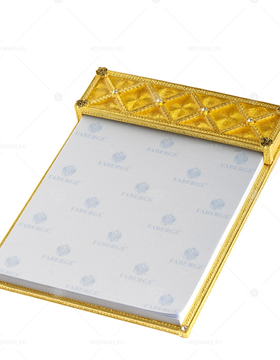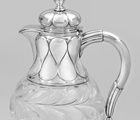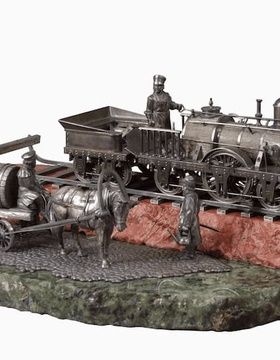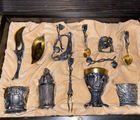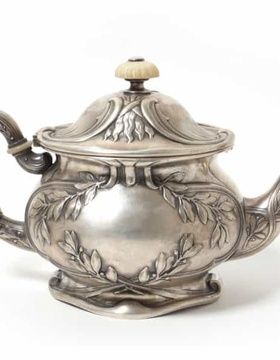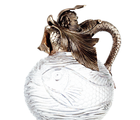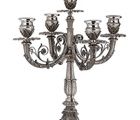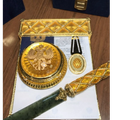
Российский ювелир Карл Фаберже прежде всего известен пасхальными яйцами, которые ценят коллекционеры по всему миру.
Это не самая очевидная форма для ювелирного изделия.
Дарить яйца на праздник Пасхи — древняя православная традиция, которую особо любят в России. По преданию, одна из жен-мироносиц, Мария Магдалина, после вознесения Христа отправилась с проповедью о Спасителе в Рим. Там она поздравила императора Тиберия словами «Христос Воскресе!», подарив ему куриное яйцо. Император не поверил словам женщины и ответил, что мертвый не может ожить, так же как и это белое яйцо не может покраснеть. Внезапно подаренное яйцо стало красным, а Тиберий убедился в истинность слов Марии.
Все началось в 1885 году, когда император Александр III заказал у петербургского ювелира Карла Густавовича Фаберже первое яйцо для своей супруги Марии Федоровны как подарок на Пасху. Император познакомился с Карлом Фаберже на выставке в Москве, где высоко оценил работы его мастерской.
Первое ювелирное яйцо, которое изготовила фирма Фаберже, — «Курочка». Название оно получило из-за сюрприза, который находился внутри — маленькой фигурки курицы из цветного золота. Подарок настолько понравился Марии Федоровне, что император стал заказывать яйца на каждую Пасху, а Карл Фаберже получил должность придворного ювелира. Требование к изделиям было всего одно: внутри яйца обязательно должен был быть сюрприз. Следующий император, Николай II, сохранил эту традицию и заказывал у ювелира сразу два яйца: для овдовевшей матери Марии Федоровны и своей супруги, Александры Федоровне.
Яйца Фаберже известны во всем мире.
Эти работы знаменитого русского мастера Карла Фаберже — мечта каждого коллекционера. Фирма Фаберже стала известна в 1885 году, когда император Александр III приобрел у него для своей жены подарок.
Это было эмалированное белое яйцо, размером 6.5×3.5 см. Посередине него проходила золотая полоса. На этом уровне яйцо открывалось. Внутри находился желток из золота, в котором была такая же золотая курочка, а в ней — корона из рубина с рубиновой подвеской. В яйце использовался принцип матрешки. После этого подарка Фаберже стал известным. Каждый год на пасху семья императора заказывала у него яйцо, он стал ювелиром при дворе. Фаберже должен был держать в тайне дизайн будущего изделия и каждый раз делать его уникальным. Вскоре все окружение царя хотело иметь дома такие яйца, а известность Фаберже дошла и до заграничных стран.
Карл не стал массово выпускать свои сувениры. Сегодня известно 71 яйцо, сделанное мастером, 54 из них были изготовлены для семьи императора. Эти изделия отличаются дизайном и внутренним наполнением. На сегодняшний день сохранилось 62 яйца, из которых 46 императорских.
Внутри каждого яйца находился сувенир. В первом изделии Фаберже были часы от «Vacheron Constantin». В яйце «Память Азова», сделанного из зеленого гелиотропа, украшенного золотом и бриллиантами, находился маленький золотой фрегат. В сувенире императрицы Александры Федоровны из прозрачного горного хрусталя, вращались вокруг оси 12 маленьких миниатюр с пейзажами.
Самое известное яйцо в мире — «Коронационное».
Сделано оно в форме императорской кареты. Императрице Александре больше нравилось розовое яйцо «Ландыши». В нем были спрятаны портреты Николая II и его дочерей. Самое большое изделие сделано, как музыкальная шкатулка, и называется «Кремль». Яйца Фаберже уникальны, их цена растет с каждым годом и превышает в несколько раз их реальную стоимость. Даже, несмотря на тот факт, что сделаны они из драгоценных камней и металлов.
Фаберже не являлся автором всех яиц, производимых под этой маркой. С ним сотрудничали такие ювелиры, как Михаил Перхин, Эрик Колин, Август и Альберт Хольстромы и Алма Пил. Они работали не только с императорской семьей. Например, для Кельхов ювелиры сделали семь яиц, а также десять изделий для других знатных семей. Эти сувениры тоже уникальны, но по оригинальности они уступают. Многие секреты и элементы повторялись и напоминали яйца, сделанные для императора. Были, и часы, и миниатюры, и курочка с подвеской. Наиболее известное — «Яйцо Ротшильдов». Оно сделано в виде часов, внутри находится механический петух, инкрустированный драгоценными камнями. Каждый час птица поет и размахивает крыльями. Это яйцо находилось все это время в семье Ротшильдов, о нем узнали лишь в 2007 году.
Работы Фаберже в России можно увидеть в Оружейной палате и на выставках фонда «Связь времен». Для фонда яйца были выкуплены у коллекционера Форбса русским олигархом Виктором Вексельбергом. Несколько работ Фаберже находится в частных руках и в некоторых музеях по всему миру.
А вы знали, что ювелиры оттачивали свое мастерство не только в классическом направлении, но решались на смелые эксперименты?
Взгляните на уникальный натюрморт 1905 года —«Пролетарский завтрак». Яйцо с янтарным желтком разбито на кирпиче из яшмы, покрытого обрывком газеты «Ведомости Санкт-Петербургского градоначальства» от 18 октября 1905 года с текстом Высочайшего Манифеста «Об усовершенствовании государственного порядка», подписанного Николаем II (прототип конституции РФ).
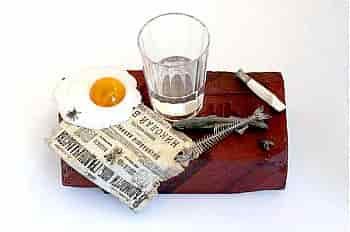
Стакан с водкой - из хрусталя, кирпич - из яшмы, желток - из янтаря (иногда Карлу приходилось бить яйца), рыба серебряная, окурок - из серебра и кварца.
Белок яйца покрыт эмалью.
Из серебра - муха и обрывок газеты.
Это "Ведомости Санкт-Петербургского градоначальства" от 18 октября 1905 года с текстом манифеста "Об усовершенствовании государственного порядка", подписанного императором Николаем II.
Оценочная стоимость - 1 100 000 долларов
Это великолепие под названием «Пролетарский завтрак фаберже» приобрел музей Фаберже в немецком Баден-Бадене. Таким образом, эта работа Фаберже стала, пожалуй, самым дорогим несъедобным завтраком в мире.
